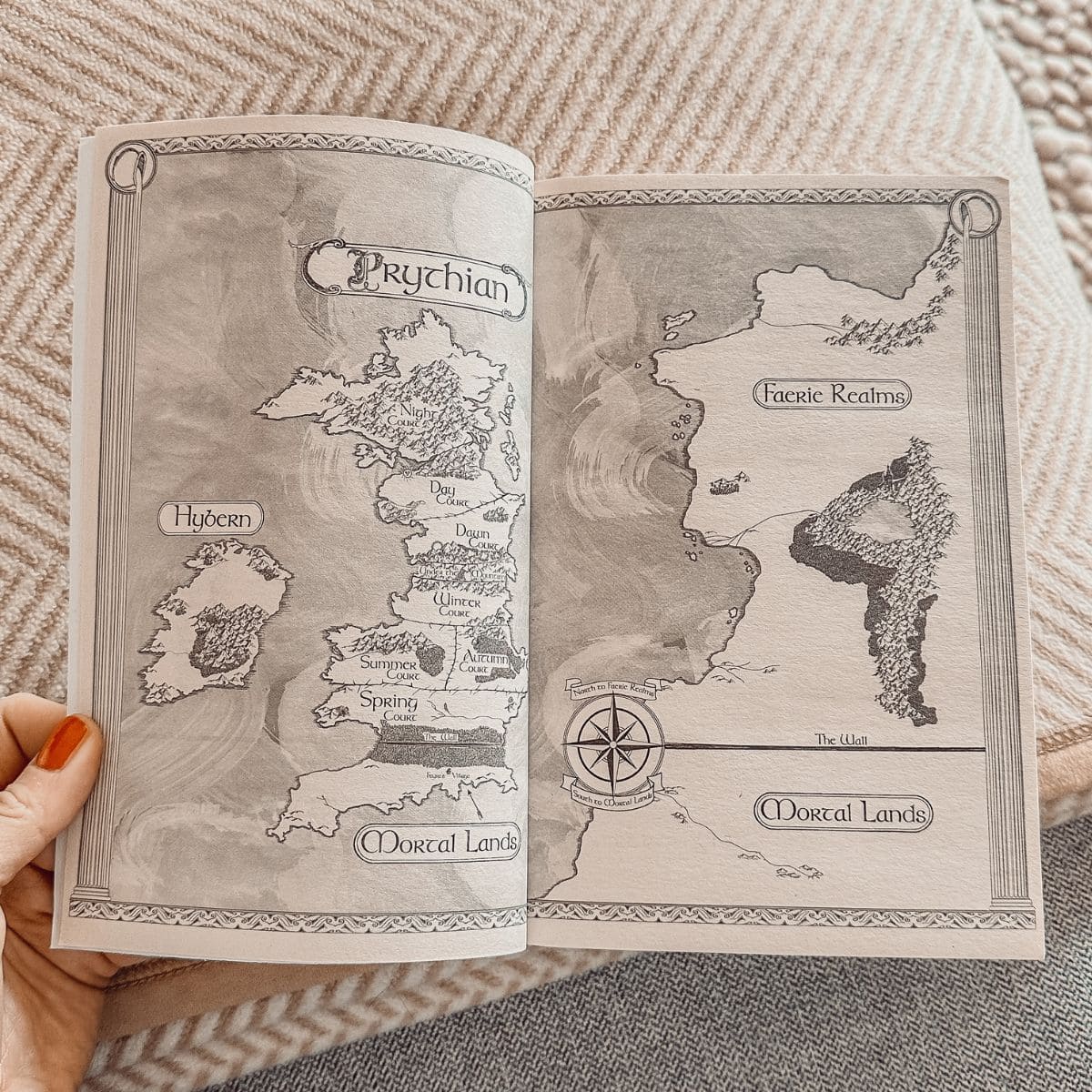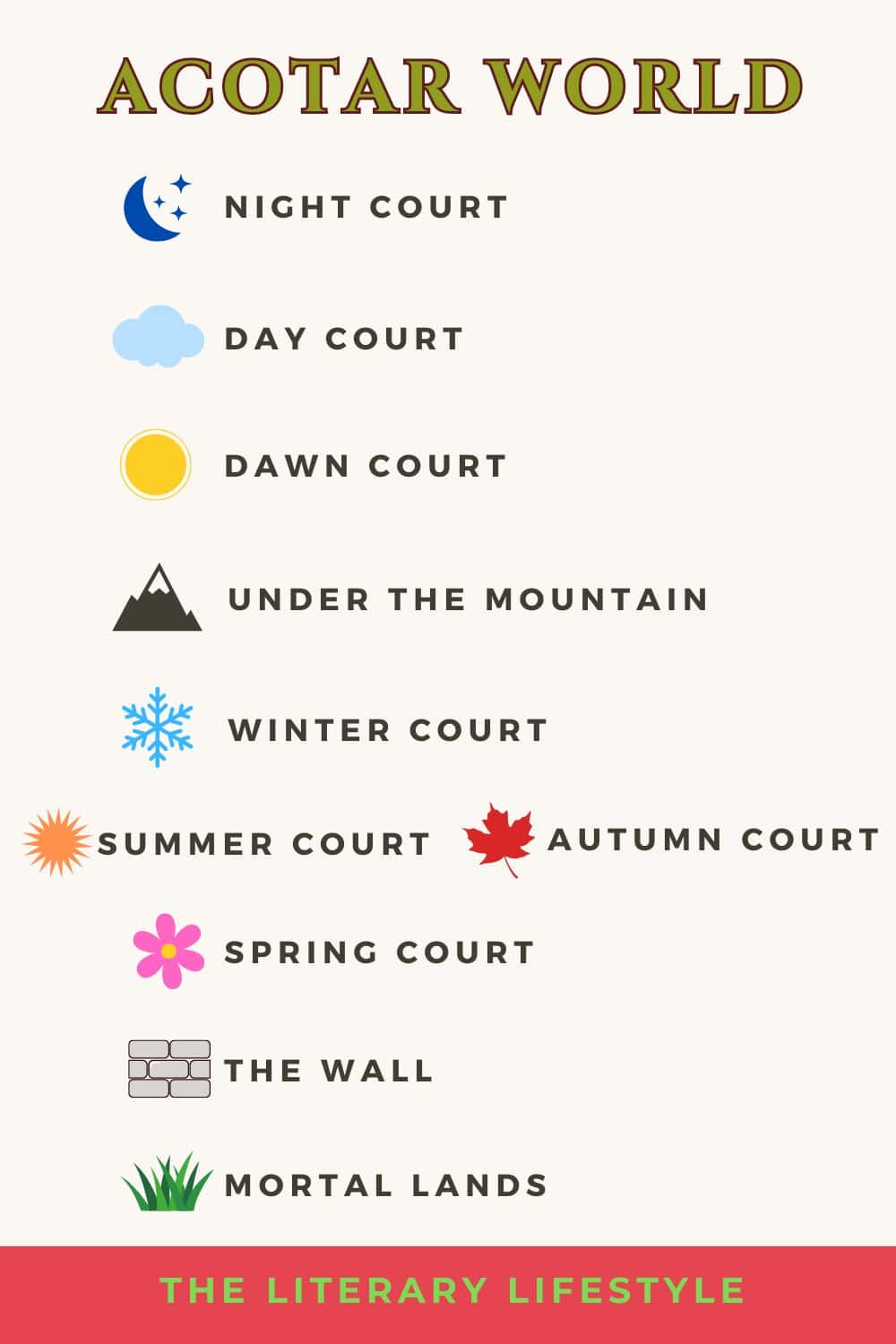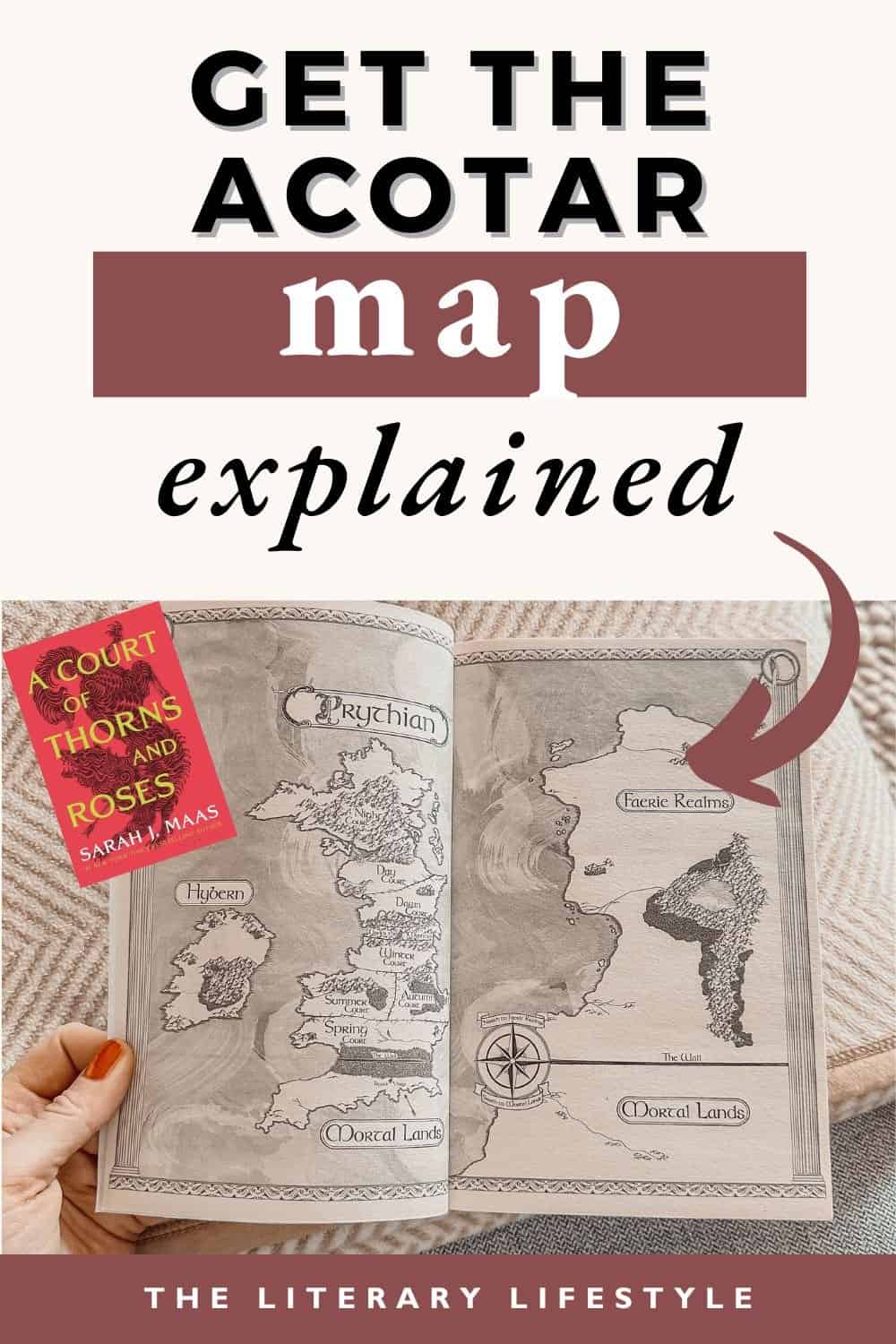Get the ACOTAR map of Prythian, Hybern, and The Continent explained with page numbers that cite book one’s world-building. It will help you read the ACOTAR book series, create fan art or fiction, and more. You’ll more easily understand and picture this fantasy book world with all my notes, so let’s get literary!

ACOTAR Map: Helpful Infographic
The island of Prythian consists of faerie lands with seven courts. To the south, in Prythian, are Mortal Lands separated by The Wall, to the west is an island called Hybern, and to the East is The Continent, which consists of Faerie Realms and Mortal Lands separated by The Wall.
Save this infographic that depicts the order of territories in Prythian.

Sarah J. Maas’s ACOTAR Map Explained
NOTE
Before proceeding, note that my notes are arranged in the order they appeared in the Kindle book, with page numbers and categories (Prythian, Mortal Lands, Tamlin’s Manor, and Under the Mountain). Where the world was built with particular detail, I quoted the book directly.
If, as you read this guide you need help with characters, check out my detailed guide to the ACOTAR characters in book one.
There are spoilers!
Read More: ACOTAR Quotes
Prythian
Long ago the mortals were slaves to the High Fae overlords, but they rebelled in the War. Six mortal queens crafted a Treaty to cease fire and construct a wall. North became High Fae and faerie lands and South were mortals. (page 28)
“[T]he High Fae still governed the northern parts of our world — from our enormous island over the narrow sea separating us from the massive continent, across the depthless fjords and frozen wasteland and sandblasted deserts, all the way to the great ocean on the other side. Some faerie territories were empires; some were overseen by kings and queens. Then there were places like Prythian, divided and ruled by seven High Lords — beings of such unyielding power that legend claimed they could level buildings, break apart armies, and butcher you before you could blink.” (page 44)
For fifty years, there has been a blight across Prythian. It spreads slowly and has made magic act strangely. “Most” have left. The masks worn by the High Fae “are the result of a surge of it that occurred during a masquerade forty-nine years ago. Even now, we can’t remove them. (page 72)
The blight is focused solely on magic in Prythian. It is not a plague or illness. It can affect humans, but it hasn’t progressed in decades. (page 73)
The barriers between the courts have “vanished.” (page 107)
“Spring, Summer, Autumn, Winter, Day, Dawn, and Night […] the Seven Courts of Prythian, each ruled by a High Lord, all of them deadly in their own way. They are not merely powerful — they are Power.” (page 128)
“Across the violent western sea, there is another faerie kingdom called Hybern, ruled by a wicked, powerful king. […] there, his territory is not divided into courts. There, he is law unto himself. Humans no longer exist in that realm — though his throne is made of their bones.” (page 129)
Hybern was the island Feyre saw on the map that “hadn’t yielded any lands to humans after the Treaty.” (page 129)
The King of Hybern was unhappy with the Treaty and resented that he was forced to sign it. “[A] hundred years ago, he dispatched his most-trusted and loyal commanders, his deadliest warriors, remnants of the ancient armies that he once sailed to the continent to wage such a brutal war against you humans, all of them as hungry and vile as he. As spies and courtiers and lovers, they infiltrated the various High Fae courts and kingdoms and empires around the world for fifty years, and when they had gathered enough information, he made his plan. But nearly five decades ago, one of his commanders disobeyed him. The Deceiver.” (page 129)
The strongest inherits the title in every Court. (page 160)
“The Spring Court was a land of rolling green hills and lush forests and clear, bottomless lakes. Magic didn’t just abound in the bumps and the hollows — it grew there.” (page 169)
Calanmai is “Fire Night” in Spring Court. They light bonfires, and their magic helps regenerate the land. (page 178) It’s the official start of spring in Prythian and the mortal world, and each of the High Lords perform the Great Rite. The magic turns them into the Hunter seeking the Maiden. Tamlin will hunt down the white stag for a sacrificial killing, then enter the sacred cave and choose a female faerie for the night. Then, the remainder mingle. (page 193)
Night Court was the northernmost part of Prythian, and it was a land of “darkness and starlight.” (page 217)
Summer Court used to celebrate the Summer Solstice, but now Spring Court has one too. (page 221)
A hundred years ago, Amarantha appeared as an emissary from Hybern and became High Queen of Prythian. (page 278)
Mortal Lands
Two days’ journey to and from The Wall. (page 2)
Feyre’s territory is too small and poor for a standing army to monitor the wall with Prythian. (page 27)
Targeted Fae attacks there were getting worse. (page 28)
The rabbits make warrens in the grove south of the big bend in Silverspring Creek. (page 40)
Tamlin’s Manor in Spring Court
Sprawled across rolling green land encased by woods. Has patios and balconies and is veiled in roses and ivy. (page 47)
A gravel path leads to the main doors. (page 47)
An array of amethyst irises, pale snowdrops, and butter-yellow daffodils (page 47)
A grand marble staircase leads to giant oak doors. (page 48)
Black and white checkered marble floor flows to doors and a sweeping staircase. A long hall stretches to giant glass doors at the other end of the estate, where there is a grander garden. (page 48)
Vases with hydrangea on the hall tables (page 49)
Polished wood doors to the left. Swung open, they reveal a long table. (page 49)
A paneled wall beside the door (page 50)
“Halls of gold and silver” (page 54)
“[Feyre’s] bedroom was larger than our entire cottage. Its walls were pale green, delicately sketched with patterns of gold, and the moldings were golden as well.” Ivory furniture and rugs with a gigantic bed were of a similar color scheme. The curtains hung from the towering headboard. (page 55) Silk emerald curtains with gold velvet (page 56)
The study was more like a library. There were “small labyrinths of stacks flanking the main area and a mezzanine dangling above, covered wall to wall in books.” (page 114)
“[The mural] told a story with the way colors and shapes and light flowed, the way the tone shifted across the mural. The story of … of Prythian. It began with a cauldron. A mighty black cauldron held by glowing, slender female hands and a starry, endless night. Those hands tipped it over, golden sparkling liquid pouring out over the lip. No — not sparkling, but … effervescent with small symbols, perhaps of some ancient faerie language. Whatever was written there, whatever it was, the contents of the cauldron were dumped into the void below, pulling on the earth to form our world … The map spanned the entirety of our world — not just the land on which we stood, but also the seas and the larger continents beyond. Each territory was marked and colored, some with intricate, ornate depictions of the beings who had once ruled over lands that now belonged to humans. All of it, I remember with a shutter, all of the world had one’s been theirs — at least as far as they believed, crafted for them by the bearer of the cauldron. There was no mention of humans — no sign of us here.” (page 114)
“It was hard to look at the next panel. It was so simple, yet so detailed that, for a moment, I stood there on that battlefield, feeling the texture of the bloodied mud beneath me, shoulder to shoulder with the thousands of other human soldiers lined up, facing the faerie hoards who charged at us. A moment of pause before the slaughter. The humans’ arrows and swords seem so pointless against the High Fae in their glimmering armor, or the faeries bristling with claws and fangs. I knew — knew without another panel to explicitly show me — the humans hadn’t survived that particular battle. The smear of black on the panel beside it, tinged with glimmers of red, said enough. Then another map, of a much-reduced very realm. Northern territories had been cut up and divided to make room for the High Fae, who had lost to the south of the wall. Everything north of the wall went to them; everything south was left as a blur of nothing. A decimated, forgotten world — as if the painter couldn’t be bothered to render it. I scanned the various lands and territories now given to the High Fae. Still so much territory — such monsters power spread across the entire northern part of our world. I knew they were rolled by kings or queens or councils or empresses, but I’d never seen a representation of it, of how much they’ve been forced to concede to the South, and how crammed their lands now were in comparison. Our massive island had fared well for Prythian by comparison, with only the bottom tip given over to us miserable humans. The bulk of the sacrifice was borne by the southernmost of the seven territories: a territory painted with crocuses and lambs and roses. Spring lands. I took a step closer, until I could see the dark, ugly smear that acted as the wall — another spiteful touch by the painter. No markers in the human realm, nothing to indicate any of the larger towns or centers, but … I found the rough area where our village was, and the woods that separated it from the wall.” (page 115)
The mural depicts the Spring Court as filled with trees in bloom, fickle storms, and young animals. (page 116)
“The six other courts of Prythian occupied a patchwork of territories. Autumn, Summer, and Winter were easy enough to pick out. Then above them, two glowing courts: the southernmost won a softer, pedder palate, the Dawn Court; above, in bright gold and yellow and blue, the Day Court. And above that, perched in a frozen mountainous spread of darkness and stars, the sprawling, massive territory of the Night Court. There were things in the shadows between those mountains — little eyes, gleaming teeth. A land of lethal beauty.” (page 116)
“I might have examined the other kingdoms across the seas that flanked our lands, like the isolated faerie kingdom to the west that seemed to have gotten away with no territory loss and was still law onto itself, had I not looked to the heart of that beautiful, living map. In the center of the land, as if it were the core around which everything else had spread, or perhaps the place where the cauldron’s liquid had first touched, was a small, snowy mountain range. From it arose a mammoth, solitary peak. Bald of snow, bald of life — as if the elements refused to touch it.” (page 116)
Lucien’s room feels like Autumn woods, with hues of orange, red, and gold, and traces of green and brown. There was a worn worktable covered in weapons. (page 120)
Tamlin closed the gallery off when he inherited the estate. (page 146)
Legend has it that if Feyre drinks from the reflecting pool behind the garden she will be happy until her last breath. (page 161)
The gallery had wooden floors, bright light, and a few large chairs and benches. A variety of art (pastorals, portraits, still lives) flowed seamlessly. Some had colors that seemed to come from a creature unlike Feyre. (pages 168-169)
Tamlin’s father planted the rose garden for his mother as a mating present. (page 170)
There are stables with horses. (page 179)
Under the Mountain
Amarantha’s court, where she built a palace. (page 280) She keeps the High Lords, other than Tamlin, and their courts there. Tamlin was allowed to stay in Spring Court until the curse ran out. (page 285)
No faeries can cross The Wall without Amarantha’s permission, so it’s clear she had been sanctioning attacks. (page 287)
No human who goes Under the Mountain ever comes out. (page 288)
There, Feyre shouldn’t drink the wine, make deals, or trust anyone. (page 291)
A “vast chamber carved from pale rock, upheld by countless carved pillars” with two ancient, enormous stone doors, taller than Tamlin’s manor. The carvings depicted faeries, High Fae, and animals, and stories of Prythian were etched on them. “Chandeliers of jewels hung between the pillars, staining the red marble floor with color.” (Page 295)
On the wall of the enormous cavern, there hung a burned young woman’s body. (Clare Beddor) (page 299)
“A land of violent snow-capped mountains” but the rock Feyre stood on was brown and bare. (page 413)
Recap
This ACOTAR map guide helped you better understand Sarah J. Maas’s world in book one of A Court of Thorns and Roses. Remember these details:
- Prythian is an island with seven faerie Courts ruled by High Lords to the North: Spring, Summer, Autumn, Winter, Day, Dawn, and Night.
- Amarantha’s palace “Under the Mountain” is also there, between Dawn and Winter Courts.
- Tamlin’s manor is in Spring Court.
- “The Wall” separates the Mortal Lands, where Feyre lives, to the south.
- To the west is the faerie island, Hybern.
- To the east is The Continent, which consists of Faerie Realms and Mortal Lands separated by The Wall.
More ACOTAR Guides
Check out these posts about the popular fantasy romance series ACOTAR:

remember, it’s a good day to read a book. – jules


